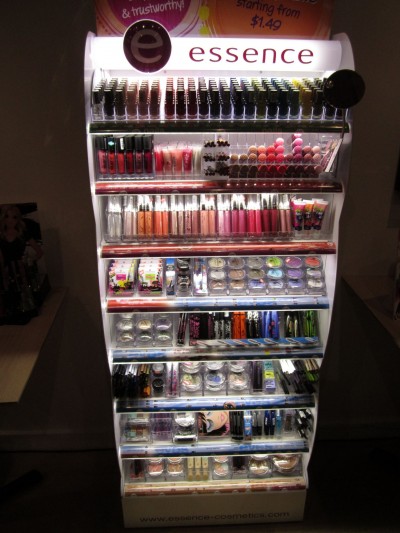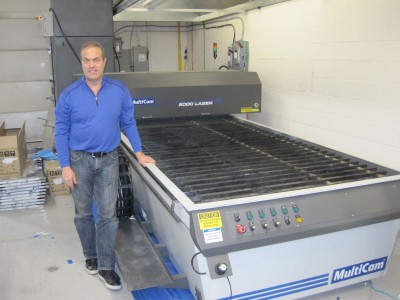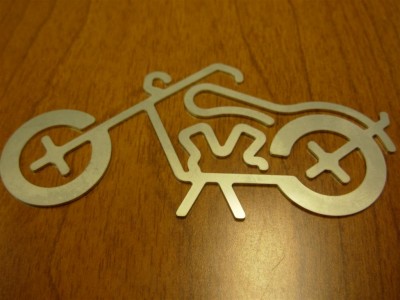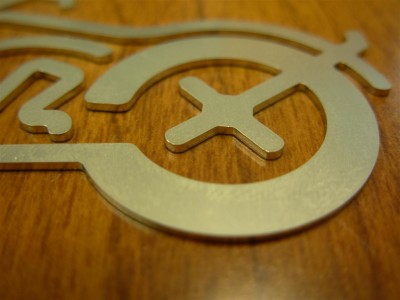Laser Cutting: A smooth edge on the competition
by all | 4 April 2013 8:30 am
 [1]
[1]Photos courtesy MultiCam Canada
By Daniel Austin
There is a growing trend with sign shops investing in laser machining systems. The technology uses high-intensity beams of varying widths for a variety of purposes, including the slotting and cutting of plastics, vinyl and mild steel.
While laser machining is still a relatively small part of the sign industry, it is slowly picking up steam, as more shops recognize the potential of integrating the technology into their operations. One company that is already seeing the benefits of making the transition to laser-based manufacturing is Toronto-based DisplayIt Graphics, which specializes in large-format printing, signage, displays, graphics and finishing services for clients in a variety of sectors.
Boosting performance
DisplayIt is known for assisting its clients first in identifying opportunities to create value, then in developing strategies and implementing display products to capture that value. In this spirit, the company purchased a computer numerical control (CNC) laser cutter in 2012 to help expand its business.
Following a minor learning curve, the transition has apparently been very smooth. Having started to use the machine last July, the company has already seen an increase in operational performance as a result.
“Laser cutting has been great for our organization,” says owner Nick Manos. “It is very well-suited for what we do here. It has substantially improved the efficiency of our manufacturing processes and increased our profit margins.”
Specifically, the laser cutter’s smooth finishing capabilities have helped Manos eliminate several steps from DisplayIt’s traditional manufacturing process for point-of-purchase (POP) displays and other types of signage where appearance is everything.
 [2]
[2]Toronto-based DisplayIt Graphics, owned by Nick Manos, has expanded its business through CNC laser cutting.
“Before we purchased the machine, every time we cut a finished product, we had to hand-clean and polish it,” he explains. “Now, with the laser cutter, we can skip those steps and focus on producing more units. It’s increasing our productivity.”
In addition to helping DisplayIt grow as a business, laser technology has also provided the opportunity to take on projects the company may not have been capable of completing in the past, including displays for the cosmetics industry.
A flexible option
Both laser machining specifically and CNC machining in general are quickly gaining popularity across a wide range of industries, from aerospace to automotive to signage. One reason is the machines’ inherent flexibility in working with diverse material types.
CNC laser machining cuts substrates by directing a stream of carbon dioxide (CO2) through a piece of a given material and vaporizing, melting or burning it away. The fast, clean and efficient cuts are repeatable any number of times, depending on the desired volume of output. With one smooth pass of a laser beam, they can cut grooves to a specific depth without severing any material from the work piece as a whole.
Modern industrial laser cutters have benefited from years of advancements in the field. The original laser was operated by stimulating a ruby crystal, which was a very low-powered option. Moving on from these humble beginnings, however, laser machining has been propelled forward by a fair share of significant developments, yielding the powerful and efficient systems used today.
 [3]
[3]With a minimal heat-affected zone (HAZ), lasers help prevent distortion of the material being cut.
The laser beam itself is characterized as coherent radiation of a single wavelength, which is advantageous because the wavelength will not dissipate its energy very quickly. It is well-suited to handle the energy transfer needed to cut many different materials.
As mentioned, modern lasers use CO2. The gas is the stimulated medium, just as the ruby crystal was in the beginning.
Lasers are well-suited for cutting because the process involves polarizing and focusing a beam of high-power light onto the work piece, such that it will melt or burn along the cutting line, ensuring a clean edge.
To clear the cut and prevent any potential combustion from occurring, cut-assist gases are aligned with laser beams. These gases help eject any melted materials clean away from the cutting area. Some examples include air, oxygen and nitrogen, each of which is responsible for a different degree of cutting.
Nitrogen, for example, is used when cutting stainless steel, as it provides a ‘shield’ that protects the hot stainless steel from surrounding oxygen. This is similar to the use of argon in welding processes.
The laser beam is directed to the cutting head by customized, water-cooled mirrors with special lenses made of zinc selenide (ZnSe). The beam diameter before the lens is about 25 mm (1 in.), which is the reduced to 0.25 mm (0.01 in.) at the focal point where cutting occurs.
Deeper benefits
It is helpful for signmakers to familiarize themselves with the basic science and process behind laser technology, as they can then fully understand where laser cutting would be useful in their manufacturing processes.
 [4]
[4]As there are no cutting tools coming into contact with the material, lasers can be used for precision cutting of delicate substrates.
 [5]
[5]As mentioned, the basic advantages of laser cutting include its flexibility, efficiency and cleanliness. The following, however, are some of the more specific advantages in terms of improving the manufacturing processes of even the smallest of companies:
- Low fixture costs.
- High feed rates.
- Multiple-axis capabilities, requiring fewer parts.
- Cutting tools that do not come directly into contact with the material, reducing wear and tear.
- Improved yield, producing more parts per sheet of material with less scrap.
- Increased savings through this more efficient use of material.
- Efficient and less expensive production of prototypes and small to large runs, as no tooling is involved.
- Ability to react quickly and adapt to changing markets and production needs, with smaller quantities.
- Improved processing, whereby multiple jobs can be combined and cut in a single batch.
- Reduced setup time.
- Cleaner, safer work environment.
- Improved speed, accuracy, consistency and control in the manufacturing process.
- Quicker turnover, as laser-cut materials that require no edge cleaning can more readily be shipped to customers.
- Reduced inventory, due to improved production-run efficiency.
- Improved product appearance, as the lasers’ minimal heat-affected zone (HAZ) helps prevent distortion.
- Reduced risk of injury compared to more traditional mechanical cutting methods.
These are just some of the benefits companies like DisplayIt are experiencing today because they invested in laser machining technology.
Daniel Austin is sales and marketing manager for MultiCam Canada, which provides automated CNC cutting systems for the sign industry. For more information, visit www.multicam.ca[6].
- [Image]: http://www.signmedia.ca/wp-content/uploads/2014/02/essence-003.jpg
- [Image]: http://www.signmedia.ca/wp-content/uploads/2014/02/IMG_3155.jpg
- [Image]: http://www.signmedia.ca/wp-content/uploads/2014/02/IMG_3169.jpg
- [Image]: http://www.signmedia.ca/wp-content/uploads/2014/02/DSCN1531-Large.jpg
- [Image]: http://www.signmedia.ca/wp-content/uploads/2014/02/DSCN1530-Large.jpg
- www.multicam.ca: http://www.multicam.ca
Source URL: https://www.signmedia.ca/a-smooth-edge-on-the-competition/